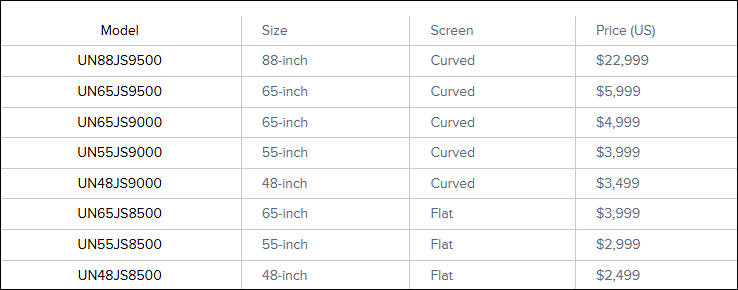
-
First tests
The Samsung UE65JS9500 is easily the most impressive LED TV we’ve reviewed to date, which is hardly surprising given that it’s kitted out with all the most desirable LCD-enhancing technologies known to videophiles. VA-type LCD screen for a natively deep shade of blacks? Check. 10-bit panel for smoother gradation and less posterization? Check. Direct-lit LED placement for better backlight/ screen uniformity? Check. Full-array local dimming to achieve inkier blacks and greater contrast? Check. Black frame insertion to boost motion sharpness? Check. Quantum dots for improved colour reproduction, higher efficiency and brighter transmittance? Check. HDR for richer detail, contrast and colours? Check. At this rate, we’re actually shocked that it doesn’t make coffee and put out the bin too.
-
I wonder if the only difference between the UN65JS8500 and 9500 will be the curve. If so, I like that the proper design (flat) is cheaper. If not, I feel somewhat ripped off that all those nice features only come with an unwanted curve.
-
It would be foolish to spend this kind of money on an "LED" TV when LG OLEDs at similar prices are just around the corner.
-
It would be foolish to spend this kind of money on an "LED" TV when LG OLEDs at similar prices are just around the corner.
For years, they are just around the corner. :-) They are not very cheap either.
And OLED TVs have real serious issues (hence the manufacturers dropping them). One being life of blue OLED and also colors degradation with time (not important for cameras and phones, but with hard used TV it is quite obvious with time). Another is memory effect. LG actually sells you thing that is more similar to LCD TV with per pixel backlighting (all of them being white OLEDS). People slightly fail to understand it.
-
Rather, the 4k ones are soon available - full HD ones are widely available now. 55EC9300 can be had for 2000-2500 USD.
Samsung dropped big screen OLED since they didn't have the tech to make them at a profit. Sony makes them for pro video monitors.
Yes LG's WRGB is basically per sub-pixel backlighting. The issues you mentioned certainly exist, but to what degree they affect LG's models it's hard to say. I've been following avsforum closely for the last year. It's my impression that the OLEDs are less susceptible to burn in than plasmas. Long-term issues are yet to be seen, and of course will vary based on how the display is used. A display at half the brightness will likely last twice as long. Remember that with zero blacks the brightness can be turned to an incredibly low level (for dark-room viewing) while still having a contrast ratio better than an LCD.
I had one (55EA9700) in my living room in September, but returned it due to a few issues. Mainly because the input lag was too high (probably a software issue). Also, the near black uniformity was poor (RGB 0-8). I was blown away by picture quality. LCD cannot compare. One must see an LCD and OLED side by side to appreciate the difference - with OLED it's like a haze of blue has been lifted away, and of course the obvious difference of zero blacks.
-
One thing many people do not mention - contrast is also affected by the light in your room. OLED actually require strong and complex filters to keep contrast at same level as LCD in bright room.
Also, LG approach leads to much lower dynamic resolution of TVs, as well as leads to same pixel switch time as on LCD.
OLED makes very good impression, but huge issues are on the way for it to become mainstream. Companies invested amazing amount of money, yet almost all dropped development of panels intended for long time use. Samsung is still dedicated for making them for phones and tablets, but it is not LG tech.
-
US prices announced officially.
It seems that they even rized top set price.
- 65" JS9500 SUHD TV will start at $6500
- 48" JS9000 SUHD will be $3500
- 55" JS8500 series runs $3000
- 65" JS8500 is $3999
Howdy, Stranger!
It looks like you're new here. If you want to get involved, click one of these buttons!
Categories
- Topics List23,992
- Blog5,725
- General and News1,354
- Hacks and Patches1,153
- ↳ Top Settings33
- ↳ Beginners256
- ↳ Archives402
- ↳ Hacks News and Development56
- Cameras2,367
- ↳ Panasonic995
- ↳ Canon118
- ↳ Sony156
- ↳ Nikon96
- ↳ Pentax and Samsung70
- ↳ Olympus and Fujifilm101
- ↳ Compacts and Camcorders300
- ↳ Smartphones for video97
- ↳ Pro Video Cameras191
- ↳ BlackMagic and other raw cameras116
- Skill1,960
- ↳ Business and distribution66
- ↳ Preparation, scripts and legal38
- ↳ Art149
- ↳ Import, Convert, Exporting291
- ↳ Editors191
- ↳ Effects and stunts115
- ↳ Color grading197
- ↳ Sound and Music280
- ↳ Lighting96
- ↳ Software and storage tips266
- Gear5,420
- ↳ Filters, Adapters, Matte boxes344
- ↳ Lenses1,582
- ↳ Follow focus and gears93
- ↳ Sound499
- ↳ Lighting gear314
- ↳ Camera movement230
- ↳ Gimbals and copters302
- ↳ Rigs and related stuff273
- ↳ Power solutions83
- ↳ Monitors and viewfinders340
- ↳ Tripods and fluid heads139
- ↳ Storage286
- ↳ Computers and studio gear560
- ↳ VR and 3D248
- Showcase1,859
- Marketplace2,834
- Offtopic1,320





